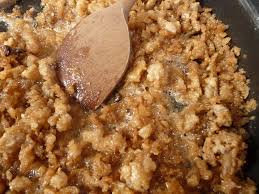Lard is pork (belly) fat. When fats were not dirty, and people were not fat, it was diced with here and there a shred of meat. Or better yet, is turning it trough the meat grinder. Then you melt with less energy and have less cracklings afterwards.
 On a gentle heat it was slowly melted, and after (partial) cooling sieved through a muslin. Do not burn the fat.
On a gentle heat it was slowly melted, and after (partial) cooling sieved through a muslin. Do not burn the fat.
Melt (and retain) different types of fat (different parts of the swine) separately. They have different qualities (whiteness, hardness, taste). For example, bacon fat remains softer.
Tasty: a sandwich (with apple butter) baptized in a hot lard pan...!
The remaining cracklings can be used in omelets, salad, soup.
The lard is used like butter for baking, frying, spread and dough preparations. Also to lubricate. (wooden) axes. (Leaf) lard suet (from the kidneys) was this the best.
The early bacon pan was never ever washed. You had to be crazy to wash that delicious, precious fat away. The pan was well used daily. And if no one had stolen all leftover grease with a piece of bread, the bottom served again for the next frying. The people then had enough exercise daily. They ate fat, but were not. Now that's just the other way.
Lard was also used in cold or flu. By rubbing the chest body was isolated to sweat out the disease.
Fat of cattle and sheep is called sebum.
Also fat of goose is very good to fry or boile.
“A pig is nothing else but a horizontal man.”(Michael Bewick)
' In each pig slumbers a man.' (Cami)
